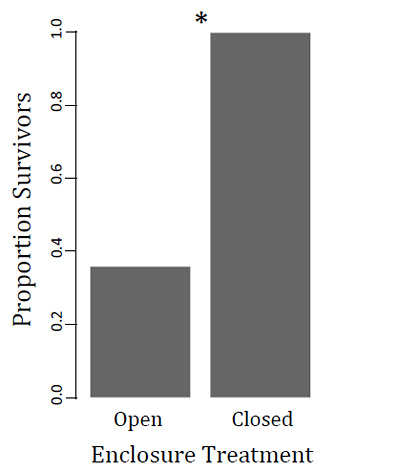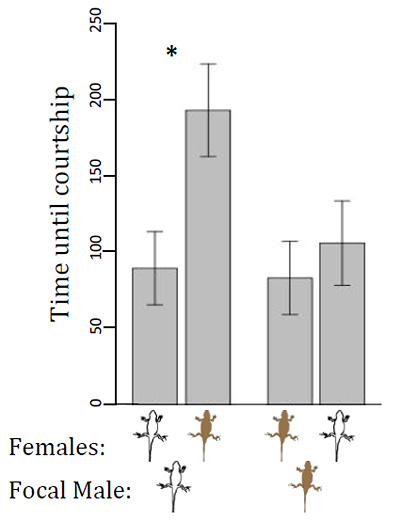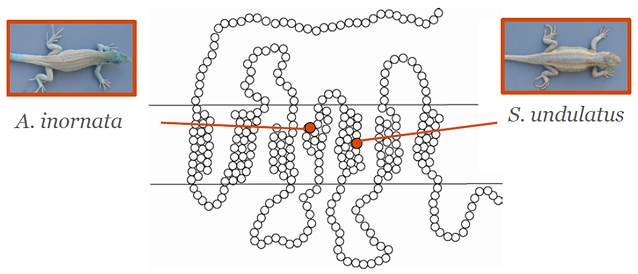When organisms adapt to a novel environment, a possible consequence is speciation (where one species splits into two or more new species). White Sands (the landscape feature) is an ideal system for studying adaptation and speciation.
White Sands formed relatively recently, and the substrate color of the white gypsum habitat contrasts dramatically with that of the surrounding Chihuahuan Desert’s dark soils habitat. Three lizard species are found in both White Sands and dark soils habitats; the lesser earless lizard (Holbrookia maculata), the eastern fence lizard (Sceloporus undulatus), and the little striped whiptail (Aspidoscelis inornata). For all three species of lizards, populations in White Sands exhibit blanched body color, while populations in dark soils exhibit a darker brown coloration (Figure 1).

Modified from Rosenblum and Harmon 2011
The evolution of blanched body color in White Sands is most likely an adaptation to avoid predation by birds. The loggerhead shrike (Lanius ludovicianus) and the greater roadrunner (Geococcyx californianus) are known to preferentially prey on individuals that are poorly matched to the substrate coloration of their habitat, and both of these species occur in White Sands.
|
Research Objectives The overall goal was to understand adaptation and speciation in White Sands lizards. Specific objectives included the following. Objective 1 - To measure rates of bird predation on lizards in White Sands. |
Methods
To measure predation on lizards, we built a number of temporary enclosures within the White Sands environment. One half of each enclosure allowed bird predators to enter freely (the “open” half), and the other half was covered with chicken wire to exclude predators (the “closed” half). We placed H. maculata exhibiting White Sands or dark soils body color (manipulated with a non-toxic paint treatment) in the enclosures, and recaptured them after two weeks.
To determine whether White Sands lizards exhibit preference for White Sands mates over dark soils mates, we conducted mate preference trials in the field. We presented White Sands S. undulatus males with local (i.e., White Sands) and non-local (i.e., dark soils) females. We quantified how quickly the male began courting each female, as well as how much total time the male spent courting the female.
To quantify differences at the genetic level between White Sands and dark soils lizards, we captured a number of S. undulatus, A. inornata, and H. maculata individuals from White Sands and dark soils populations. We took tissue samples from all individuals and then released lizards at the place they were found. We used genetic techniques to obtain DNA sequence data and compared the degree of DNA sequence similarity between White Sands and dark soils lizards.
Results

We found strong evidence of predation on lizards in White Sands. An average of 56 percent of lizards were recaptured from open halves of enclosures (Figure 2). In contrast, 100 percent of lizards were recaptured from closed halves of enclosures. In addition, we determined that bird predators were most likely responsible for the observed mortality in open enclosures. Birds most commonly observed in and around enclosures included loggerhead shrikes, greater roadrunners, Chihuahuan ravens (Corvus cryptoleucus), and northern mockingbirds (Mimus polyglottos). Although we observed high rates of predation in enclosure trials, body color did not appear to affect lizard survivorship, and we are now refining our experimental design to better test for the effect of camouflage on lizard survival at White Sands.
White Sands males preferentially courted local females (i.e., began courting White Sands females more quickly than dark soils females, and spent a longer total amount of time courting White Sands females than dark soils females; Figure 3). In contrast, males from dark soils populations did not exhibit a preference for local mates (i.e., they courted White Sands and dark soils females similarly). We also found that aspects of female behavior and female body color influenced male courtship.

Modified from Hardwick et al. 2012
Genetic differentiation between White Sands and dark soils populations varied from species to species. A. inornata exhibited little to no genetic differentiation between White Sands and dark soils habitats. S. undulatus showed intermediate levels, and H. maculata had a high degree of genetic differentiation by habitat. These results could be explained by patterns of geographic structure among species; H. maculata is a habitat specialist with small isolated populations, S. undulatus is distributed more continuously than H. maculata, but has limited dispersal across populations, and A. inornata is continuously distributed with high dispersal rates. We also found a specific genetic mutation responsible for blanched color in two of the three White Sands species. Mutations in the melanocortin-1 receptor gene (Mc1r) appear to cause light coloration in S. undulatus and A. inornata (Figure 4).

Modified from Rosenblum et al. 2009
Discussion
Research to date indicates that White Sands and dark soils lizards are in the process of adapting to distinct environments, and that S. undulatus, A. inornata, and H. maculata exhibit varying degrees of progress towards speciation. Specifically, we have learned that
- Lizards in White Sands experience high rates of predation from local birds. This suggests that characteristics that help lizards avoid predation, such as camouflage, likely play an important role in survival in White Sands.
- White Sands lizards prefer other White Sands individuals as mates. This indicates that some degree of reproductive isolation exists in the White Sands system, where White Sands and dark soils lizards do not frequently interbreed.
- Though all three species of lizards exhibit similar locally adaptive traits (i.e., blanched color in White Sands), they also exhibit varying degrees of genetic differentiation between White Sands and dark soils populations. This suggests that species-specific traits, such as dispersal rate, can play an important role in determining the degree of progress towards speciation. It is also remarkable that two of the three White Sands lizards have mutations in the exact same gene responsible for light coloration.
White Sands lizards provide us with a unique opportunity to gain insight into the process of adaptation and speciation. In the future we will
- Conduct more extensive enclosure studies to further investigate the role of color on survivorship, as well as seasonal and geographic variation in predation rates;
- Perform additional experiments to determine which characteristics (e.g., visual cues such as body color and mating display behavior, chemical cues such a pheromones) are used to inform mate preference; and
- Identify additional traits important for adaptation to the White Sands environment, and determine the genetic basis of those traits (i.e., locate the genes and the mutations within those genes responsible for adaptive characteristics).
Overall White Sands represents one of the most promising systems in the world to understand how quickly animals can adapt to new environments and how the process of speciation unfolds in nature.
For more information, contact:
Kayla Hardwick, kaylamh6@gmail.com
Erica Bree Rosenblum, rosenblum@berkeley.edu
Department of Environmental Science, Policy, and Management
University of California-Berkeley
References
Hardwick, K. M., J. M. Robertson, and E. B. Rosenblum. 2012. Asymmetrical mate preference in recently adapted White Sands and black lava populations of Sceloporus undulatus. Current Zoology 59: 20-30.
Rosenblum, E. B. and L. J. Harmon. 2011. Same same but different: replicated ecological speciation at White Sands. Evolution 65: 946-960.
Rosenblum, E. B., H. Rompler, T. Schoneberg, and H. E. Hoekstra. 2009. Molecular and functional basis of phenotypic convergence in white lizards at White Sands. Proceedings of the National Academy of Sciences 107(5):2113-2117.
Prepared in collaboration with the National Park Service, 2012.
Last updated: January 3, 2017
